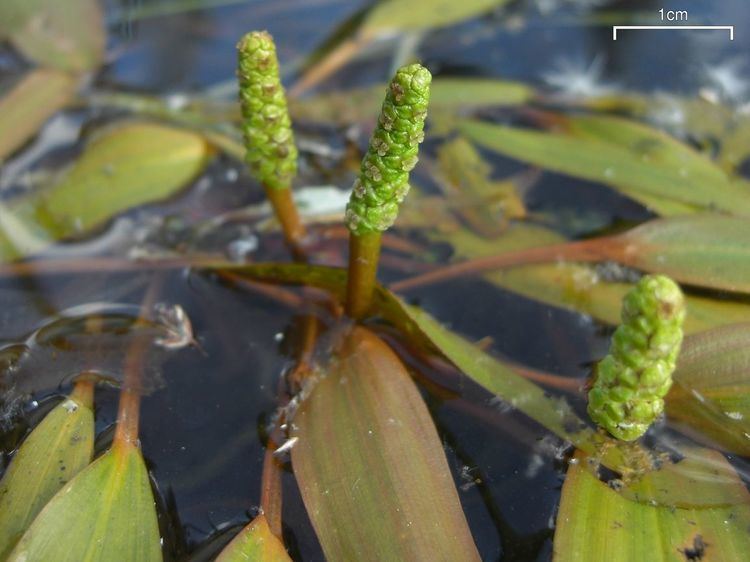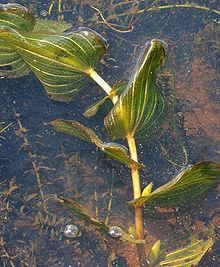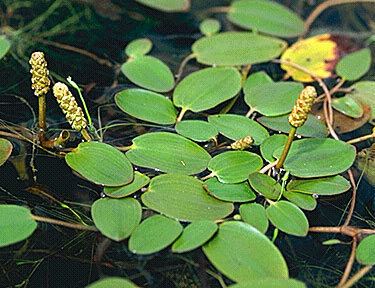Scientific name Potamogeton Rank Genus | Family Potamogetonaceae Higher classification Potamogetonaceae | |
 | ||
Lower classifications Potamogeton crispus, Potamogeton natans, Potamogeton perfoliatus, Potamogeton lucens, Potamogeton gramineus | ||
Sago pondweed potamogeton pectinatus
Potamogeton is a genus of aquatic, mostly freshwater, plants of the family Potamogetonaceae. Most are known by the common name pondweed, although many unrelated plants may be called pondweed, such as Canadian pondweed (Elodea canadensis). The genus name means "river neighbor", originating from the Greek potamos (river) and geiton (neighbor).
Contents
- Sago pondweed potamogeton pectinatus
- Clasping leaf pondweed potamogeton perfoliatus
- Morphology
- Taxonomy
- Distribution
- Hybrids
- Taxonomic history
- List of Potamogeton species
- List of Potamogeton hybrids
- Ecology
- References

Clasping leaf pondweed potamogeton perfoliatus
Morphology

Potamogeton species range from large (stems of 6 m or more) to very small (less than 10 cm). Height is strongly influenced by environmental conditions, particularly water depth. All species are technically perennial, but some species disintegrate in autumn to a large number of asexually produced resting buds called turions, which serve both as a means of overwintering and dispersal. Turions may be borne on the rhizome, on the stem, or on stolons from the rhizome. Most species, however, persist by perennial creeping rhizomes. The leaves are alternate, which contrasts with the closely related genus Groenlandia, where the leaves are opposite or whorled.

In many species, all the leaves are submerged, and in these cases, they are typically thin and translucent. Some species, especially in ponds and very slow-moving waters, have floating leaves which tend to be opaque with a leathery texture.

All Potamogeton have a delicate membranous sheathing scale, the stipule, at the leaf axil. This may be wholly attached, partly attached, or free of the leaf, and it may have inrolled margins or appear as a tube. The morphology of the stipule is an important character for species identification. The flowers, which are often overlooked, are greenish-brown and are composed of four rounded segments borne in a spike. The fruits are spheroidal and green to brown, usually 1–3 mm in diameter, with a noticeable 'beak'.
Most fine-leaved pondweeds are diploid, with 2n = 26 (such as P. pusillus or P. trichoides) or less commonly 28 (P. compressus, P. acutifolius). Broad-leaved taxa are mainly tetraploid, with 2n = 52 (e.g. P. alpinus, P. praelongus), but a few species are diploid (e.g. P. coloratus or octaploid (2n = 104)(e.g. P. illinoensis).
Taxonomy
Potamogeton species are found throughout the world in standing or running water. In a detailed review of the genus, Wiegleb and Kaplan recognised 69 species, but the variability of many species means that there is disagreement regarding the exact number of species. Currently, the number of accepted names is 94. Hybridisation provides an added complexity to the taxonomy.
The genus has been split into several sections. Section Potamogeton contains the larger broad-leaved species such as P. natans, P. perfoliatus and P. alpinus. Section Graminifolii consists of fine-leaved species such as P. rutilus, P. compressus and P. berchtoldii. Series Batrachoseris contains only one species, Potamogeton crispus. Subgenus Coleogeton, containing P. pectinatus, P. filiformis and P. vaginatus, is now considered to belong to a separate genus, Stuckenia. These general divisions have been supported by molecular analysis, except that P. crispus clusters with broad-leaved species in section Potamogeton.
Distribution
Potamogeton species are found worldwide in many aquatic ecosystems. However, the greatest diversity of species occurs in the northern hemisphere, especially in North America, which is thought to be where the genus originated. Molecular evidence suggests that several independent colonizations of the southern hemisphere have occurred.
Hybrids
Potamogeton species hybridise freely. At least 27 hybrids have been observed in the British Isles alone, and more than 50 worldwide, of which 36 have been confirmed using genetic techniques. The majority of these are sterile, but many are long-lived and may occur in the absence of one or even both parents. Most hybrids have been described between broad-leaved species, but this probably reflects the relative scarcity of characters among fine-leaved taxa, so that hybrids are much more difficult to identify. Use of genetic markers suggests that hybrid taxa are also reasonably frequent among fine-leaved species. At least one species, P. obtusifolius, is thought to have arisen via hybridisation.
Taxonomic history
Several species of European pondweeds, including P. natans, P. lucens and P. crispus, were included in Linnaeus's Species Plantarum in 1753. Much of the European Potamogeton flora was subsequently named during the late 18th and early 19th century. As botanists ventured further afield, pondweeds began to be collected and named from other parts of the world. The North America flora was largely named by the start of the 20th century. Alfred Fryer became interested in Potamogeton in the 1880s, and was a recognised authority on the genus. The first parts of his work The Potamogetons (Pond Weeds) of the British Isles were published in 1898. His death intervened, and the work was completed by Arthur Bennett (1843-1929), who named a large number of specimens sent to him from around the world. Robert Morgan (1863-1900) illustrated Fryer's contribution to the monograph, his colour plates drawing praise from later critics.
New species continue to be described from less well-studied areas such as Asia and Africa, and it is possible that molecular analysis may reveal hitherto unknown cryptic species.
List of Potamogeton species
The following list is based on the mst up to date listing of valid Potamogeton taxa held on The Plant List.
List of Potamogeton hybrids
List source :Ecology
Reproduction of pondweeds occurs both vegetatively and by seed, though studies suggest that in some species or situations reproduction by seed is rare. The fruits may be produced in large quantities from midsumer onwards, and are ingested by waterfowl. Germination experiments have shown that the seeds are viable after passing through the digestive tracts of birds and this mechanism is probably the only natural mechanism for long-distance dispersal between isolated water bodies. Vegetative propagation occurs by a variety of mechanisms including turions, and via growth and fragmentation of rhizomes and shoots. Vegetative reproduction is evidently an effective means of ensuring local persistence, as sterile hybrids have been recorded at some sites for over 100 years.
Although they occur in a range of environments, most species prefer standing or slow-flowing waters with some calcium and fairly low nutrient levels. In general the fine-leaved species are more tolerant of human impacts such as eutrophication. They are important as food and habitat for animals including insect larvae, water snails, ducks and other waterfowl, and aquatic mammals such as beavers.
Most species are not weedy, but a few can become troublesome, such as curly-leaf pondweed (Potamogeton crispus).
